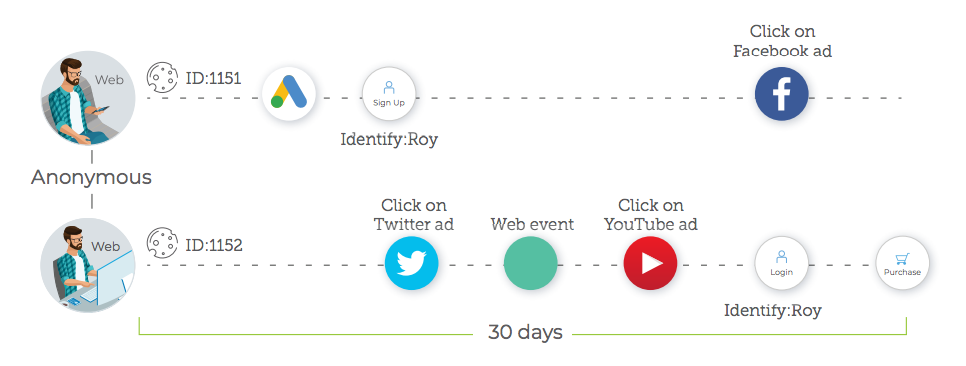
Cross-device
Cross-device refers to the measurable scenario in which users move through and convert along the conversion funnel, via two or more devices.
What does “cross-device” mean?
Cross-device user behavior refers to the way in which a user may engage with a given funnel through two or more different devices at various times throughout the journey. Within the cross-device journey, the same or multiple platforms (mobile web, desktop web, etc.) or channels (social media, email, push notifications, etc.) may be used.
Some of the devices include:
- Smartphones
- Tablets
- Personal computers
- TV sets
- Smart TVs/OTT
Subsequently, cross-device measurement refers to the process, supported by increasingly more sophisticated attribution technology, of following this fragmented user journey across devices, and uniting the various touchpoints under some form of unique user identification.
Historically, cross-device attribution was close to impossible, because each device’s web-based touchpoints had a different associated web cookie with no matching identifier.
Subsequently, given the short lifespan of the web cookie, as well as the growing restrictions on its use, attribution providers have turned to other solutions to bridge the gap: Standardization of web browsers to javascript and HTML, emergence of mobile device IDs (IDFA and GAID), and the use of unique customer user IDs for unified measurement.

Another way of bridging the cross-device gap is via smart banners, or banners at the top of your mobile web screen that drive visitors to browse using the app. These call-to-actions often go hand-in-hand with campaigns offering promotions and deals for in-app users.
For example, a 5-10% discount for in-app purchasing rather than the website. Through the deep links placed in these smart banners, marketers can bring users to install their app, and then automatically refer them to other in-app pages, either that were previously viewed or that may be related to their browsing history.
Why is cross-device measurement important?
Holistic, cross-device measurement and attribution has been a significant marketing pain point, and aspiration, for at least 10 years. That’s because many modern marketers still struggle to connect fragmented marketing touchpoints and single users. Nowadays, it is simply a fact that a significant divide between user behavior and marketing measurement is evident.
However, cross-device measurement solves these challenges and reaps the following benefits, among others:
- Measure true ROAS and LTV. Measuring each of your marketing channels in silo inevitably means missing a piece of the puzzle, and therefore understanding both the true lifetime value of your users and the profitability of your ad spend. Analyze holistically across your TV, web, and mobile channels will show gaps or increases in these metrics, informing smarter budgeting decisions.
- Prevent audience overlaps and duplication. Siloed advertisements lead to overexposure, poor engagement, brand damage, and budget waste. Keep audiences separate by knowing which users are using multiple devices in a cross-device view, as well as how far down the conversion funnel they’ve reached at any point.
- Get more credit for your work. Without a holistic, cross-device view of a user journey, ads and media sources may be misattributed or even not attributed at all, for conversions that were driven on one device but actually happened on another. Your non-organic installs and hard work should be distinguished as such.
- Create consistent messaging. Leverage your cross-device picture of the user journey to create a messaging flow that is contextually relevant from start to finish, and doesn’t overload users. In turn, you will reduce churn and increase conversions from specific targeting.
- Drive users to high-converting apps. Knowing your user’s story on multiple devices not only informs performance analytics, but also gives marketers access to strategic touchpoints for driving users intentionally to their high converting apps. This is especially true for certain verticals (e.g. Finance) where traditional companies such as banks, as well as more mobile-first companies such as digital wallets, use web as a more natural touchpoint to install.



